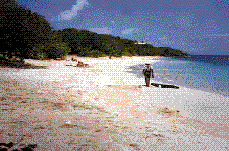| Environment and development in coastal regions and in small islands |
Coastal management sourcebooks 1
Introduction
The purpose of the present manual is to provide people with the knowledge necessary to make informed decisions about the problems resulting from coastal changes. While the manual focuses on the Caribbean, many of the conclusions and measures described could be relevant to beach systems elsewhere in the world.
T H E E N V I R O N M E N T A L S E T T I N G
Caribbean beaches are highly valued by residents for relaxation, sports and simple enjoyment. Most islanders are proud of their beaches and wish to conserve them for posterity. To others, Caribbean beaches evoke idyllic pictures of soft sand, clear waters, cool breezes and shady trees combined with the prospect of relaxed living and revitalization. The prospect of visiting such places or even living beside the beach is a dream for many people. With global travel having made remote places more accessible, such dreams are becoming reality. Yet all too often, Caribbean beaches are subject to natural disasters, inadequate planning and a lack of environmental sensitivity.
Shorelines are areas of continuous change where the natural forces of wind and water interact with the land.
These changes have been taking place for millennia. History provides the example of Cockburn Town in the Turks and Caicos Islands, where Back Street had to be renamed Front Street at the beginning of this century as erosion took its toll. Shoreline changes are the result of both natural forces and human activities, such as sand mining and beach construction.
These shifts between water and land have taken on paramount importance in the Caribbean islands since tourism became the major industry in the 1970s. Despite their economic value in a region where tourism is dependent for the most part on sun, sea and sand, beaches have unfortunately not been perceived as areas needing management, protection and funding, but rather as permanent features of the landscape.
Environmental awareness has been growing slowly. International events, such as the United Nations Conferences on Environment and Development (Rio de Janeiro, 1992) and on Sustainable Development of Small Island Developing States (Barbados, 1994), have helped to focus public attention on the need for environmental management. Yet it was the dramatic events of 1989 and 1995 that gave the region the most direct demonstration of the need for beach management; Hurricane Hugo in 1989 and the numerous hurricanes in 1995 brought home to everyone the impermanence and vulnerability of the region's beaches.
On the threshold of the third millenium, as the Caribbean enters a cycle of heightened hurricane activity against a background of global sea level rise, all islanders – whether or not they live on the shore – should be concerned about the state and future of the region's beaches.
 |
| Photograph 1. Sand beach, Pigeon Point, Antigua, 1995. An idyllic sand beach backed by sea grapes and palm trees |
 |
| Photograph 2. Eroded beach, Runaway Bay, Antigua, 1997. Erosion of the sand has caused walls to collapse leaving concrete debris on the beach as the land edge retreats inland. |
T A K I N G I N F O R M E D
A C T I O N :
S O M E
P R A C T I C A L A D V I C E
The main part of the manual (Chapter 1) has been organized around the theme of beach disappearance and erosion. A total of eleven cases describing different situations have been developed. Readers may turn to whichever case relates most closely to their particular problem or alternatively may read all eleven cases to obtain the maximum information. Each opens with a description of the environmental conditions and their causes. This is followed by a section offering practical advice on appropriate actions and responses. Considerable cross-referencing between cases serves to combine several situations.
Chapter 2 centres around the theme, ‘What to look for when investing in coastal land or property.’ It provides guidelines for prospective buyers and a checklist to help evaluate the potential of a particular site.
The third and final chapter deals with the theme ‘Protecting beaches: how you can help.’ It contains several suggestions for individuals or groups wishing to undertake projects to improve a particular beach on their island.
A glossary has been included to define potentially unfamiliar terms; for easy reference, the first mention of these in each case and in chapters two and three is highlighted in red. There is also a detailed subject index to assist the reader in locating additional information on specific items.
By adopting an action-oriented approach, the present manual is intended to help readers make informed decisions about suitable responses to beach changes on their particular island. Although beach erosion can be slowed down or the problems transferred to another section of shoreline, generally speaking, erosion is inevitable. It is hoped that use of this manual will reduce the impact of natural disasters and increase awareness of what individuals or small groups can do to preserve and protect their beaches.
| Figure 1. Map of the Caribbean region (taken from Graphi-Ogre, 1998). |
 |